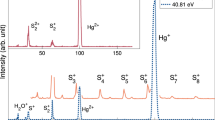Abstract
ONE of the problems in high-molecular-weight mass spectrometry is to establish unambiguously the definite mass to be assigned to the fragmentation peaks in the higher mass (200–800) range. A suitable calibrating material is stannic bromide. It has a vapour pressure at 25° C. of a little less than 1 torr, and from its elementary isotopic constitution the relative peak heights can be calculated for the molecular parent ion and its fragments.
This is a preview of subscription content, access via your institution
Access options
Subscribe to this journal
Receive 51 print issues and online access
$199.00 per year
only $3.90 per issue
Buy this article
- Purchase on Springer Link
- Instant access to full article PDF
Prices may be subject to local taxes which are calculated during checkout
Similar content being viewed by others
References
Handbook of Chemistry and Physics (Chemical Rubber Publishing Co., Cleveland, 1961).
Dibeler, V. H., and Mohler, F. L., J. Amer. Chem. Soc., 70, 987 (1948).
Norton, F. J., J. Amer. Chem. Soc., 71, 3488 (1949).
Author information
Authors and Affiliations
Rights and permissions
About this article
Cite this article
NORTON, F. Distribution Patterns of Isotopic Peaks in the Mass Spectrum of Stannic Bromide. Nature 194, 467–468 (1962). https://doi.org/10.1038/194467a0
Issue Date:
DOI: https://doi.org/10.1038/194467a0
Comments
By submitting a comment you agree to abide by our Terms and Community Guidelines. If you find something abusive or that does not comply with our terms or guidelines please flag it as inappropriate.



